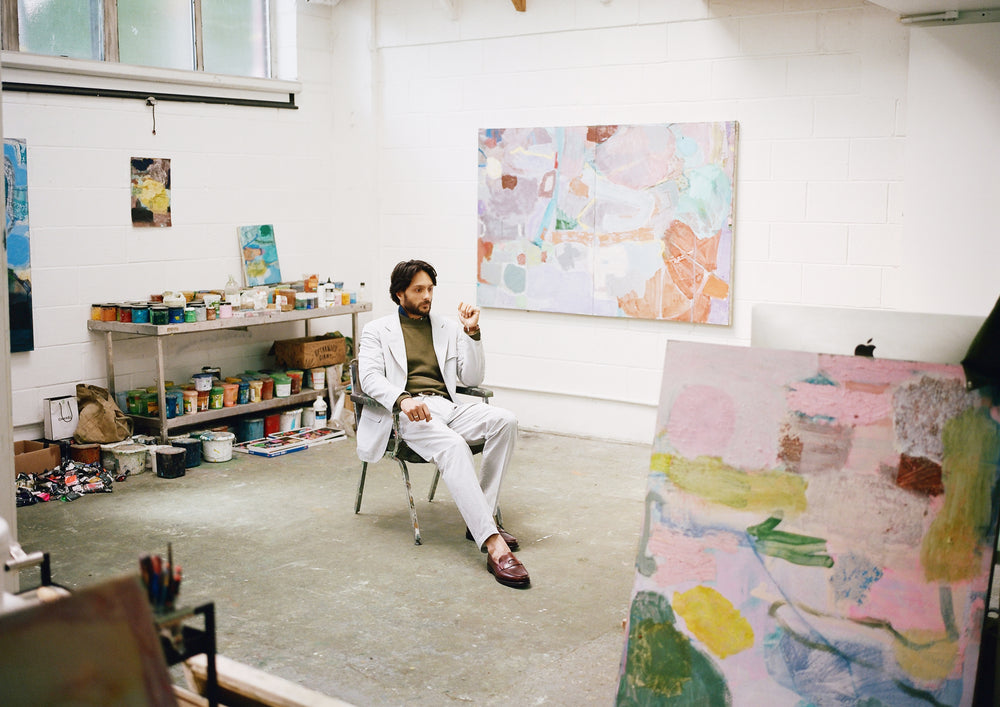ArtCommunityConversationsCultureIn the Studio
Painting from Memory with Joe Warrior-Walker
By Drake's
Jun 9, 2023

There are days when Joe Warrior-Walker doesn’t enjoy painting that much. In his studio, which he shares with his wife Alice, a fellow artist — surrounded by canvases and paints, oil, acrylic and pigment that he mixes himself, stashed in plastic bottles, a paper Chanel bag, and various soup containers, “they’re the perfect size for paint,” he says — the colours might not flow together; the concept might get lost, or muddied. “I don’t like painting, I’m not joking,” says Warrior-Walker, grimacing a bit.
“I do love finishing a body of work, and trying to improve the next one.”


Looking at it in person, which we’re doing on this clear morning in Bristol, you’d think the work came easily. A Joe Warrior-Walker canvas is a dreamy abstraction of colour and feeling. Soft pinks, warm blues, texture, light and beauty. There’s no Rothko darkness here, nor is the artist a morbid presence. Affable and quietly spoken, he has swept back hair, glasses that frame an angular face and a small hoop in one ear.
He shows us towards some work in progress, which he might return to over the course of months, the oil and pigment drying slowly, slowly, slowly. “When I tell people I’m an artist - if you’re not making portraits - it’s hard to describe. I just say I do abstracts.”


“I think you need someone to see it, the painting, up close really,” adds Joe, leaning in closer to a canvas. I like the fact that people can see whatever they want in them. Some people will see a face, or a tree. There was one woman who recently found that the sand I mix in with the paint was making her itchy!"
"Abstraction allows people to make their own minds up.”


The son of two artists, his father a painter, his mother a ceramicist, Warrior-Walker grew up in between St. Ives, in Cornwall, and India, his mother’s home country. She ran, and still runs, a textile business, his dad was a fisherman and a coal miner. “My childhood was split between Cornwall, India, Nepal and Thailand, so it was a bit unusual I suppose. When I paint now, I’m never referencing just one place. I’ll think about an Indian palette and a rural English landscape, something from the past or maybe just around Bristol. It’s my memory, rooted in time and place, with a sense of nostalgia.”


Arriving at The Chelsea School of Art in 2011, Warrior-Walker initially avoided mentioning that he was from St. Ives, a tiny parcel of the country with an outsized reputation for producing great artists. He grew up with Danny Fox and, like his fellow Cornishman, has conflicted feelings about his hometown. "I think sometimes visitors can forget that there are actually people from there,” he says. “If I ever go back during the summer, it can feel like you’re in a zoo, being gawped at.”
“There are are certain connotations to the landscape,” he adds, “and a slightly outdated movement that’s now being replicated in tourist galleries.” It can be hard to find that contemporary current, it’s all so engrained.”


As can happen with these sorts of things, Warrior-Walker spent a long time getting to a place where, today, his work is pursued by collectors and exhibited internationally. After graduating with a Masters from UEA in London, he spent years as a picture framer, painting in the evenings, on weekends, whenever he could. There was a time when he slept in his studio, caught in limbo between a move from London to Bristol. “I’ve only gone full time in the last year,” he says, “which was daunting for a while, but I still try to treat it like a job. Whether I paint for one hour, or 10, as long as I put some time in every day I feel content.”



“Joe's work, mixing Indian and Southern English pigments - reflecting his origins - through his materials to paint imaginary landscapes from his memories, definitely won us over, says the gallerist Léa Perier Loko, who exhibited a solo show of his work at Septieme Gallery in Paris last year.
“Abstract works are difficult to make truly singular and can often become quite generic,” she adds, “especially in the age of Instagram. But by painting his own story, Joe truly conveys his identity. His compositions resonate with accuracy and authenticity.
"In our opinion, he has every chance of becoming a great painter of his generation.”






Joe heads to a paint-splattered wooden drawer in his studio and pulls out a handful of works on paper — A4’ish size renderings using that same transportive palette inspired, partly, by some time spent in the nearby countryside. You could look at them all day. “Even on paper I don’t work quickly,” he says with a laugh. “I was thinking about particular colour palettes and their relationships together. The pinks and the blues, the circular shapes, interlacing grids.”
“I was just putting things together, really. I guess that's how I work."



